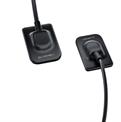
Cash App is a widely popular mobile payment service that allows users to send and receive money with ease. However, like all financial platforms, Cash App has certain sending limits that users must adhere to. These limits are in place to protect users and ensure the platform's security. Understanding these limits, how they work, and how you can increase them is crucial for maximizing your Cash App experience.
What is the Cash App Sending Limit?
The Cash App sending limit refers to the maximum amount of money you can send through the app within a specified period. Cash App imposes these limits to prevent fraud and to comply with federal regulations. When you first sign up for Cash App and create an account, you will be considered an unverified user, which means your sending and receiving capabilities are restricted.
As an unverified user, your sending limit is capped at $250 within any 7-day period. Additionally, the receiving limit is set at $1,000 within a 30-day period. These limits may seem low, but they are designed to protect both you and Cash App from potential fraud during the initial phase of using the app.
Cash App Sending Limit after Verification
Once you verify your Cash App account, your Cash App sending limit significantly increases. Verification involves providing your full name, date of birth, and the last four digits of your Social Security Number (SSN). This process is straightforward and typically takes only a few minutes to complete.
After verification, your Cash App sending limit increases to $7,500 per week and an unlimited receiving limit. This substantial increase in the sending limit allows you to use Cash App more freely, making it a more powerful tool for managing your finances. Verification also provides an additional layer of security, ensuring that your account is more robust and less prone to unauthorized access.
How Do You Increase Cash App Limits?
If you find that the default Cash App limits is too restrictive, there are several steps you can take to increase them:
- Verify Your Account: As mentioned earlier, the first and most effective way to increase your Cash App sending limits is by verifying your account. This simple process can raise your sending limit from $250 to $7,500 per week.
- Link Your Bank Account: Linking a bank account or debit card to your Cash App account not only facilitates easier transactions but also contributes to higher limits. The platform tends to trust accounts with linked bank accounts more than those without.
- Increase Usage: Regular use of Cash App can also lead to higher limits over time. As you consistently use the platform for transactions and maintain a positive history, Cash App may offer you higher limits as a loyal customer.
- Contact Cash App Support: In some cases, contacting Cash App support directly can result in an increase in your limits. This is especially useful if you need to make a large transaction and your current limits are insufficient.
Is There a Cash App Withdrawal Limit?
Yes, Cash App also imposes withdrawal limits on users. These limits apply to withdrawals made from your Cash App balance to your linked bank account or through an ATM using the Cash App card.
For standard withdrawals to your bank account, there is no Cash App limit on the amount you can transfer, but there may be a fee if you opt for an instant transfer. For ATM withdrawals, the limit is $310 per transaction, $1,000 per 24-hour period, and $1,000 per 7-day period. These limits are in place to prevent unauthorized access and ensure that your funds remain secure.
How Do You Send Money with Cash App?
Sending money with Cash App is a simple and straightforward process. Whether you're paying a friend back for dinner, splitting a bill, or sending a gift, Cash App makes it easy. Here’s how you can send money using Cash App:
- Open the Cash App: Start by opening the app on your Smartphone. Make sure you are logged into your account.
- Enter the Amount: On the main screen, you will see a green dollar symbol. Enter the amount you wish to send using the keypad.
- Tap "Pay": After entering the amount, tap on the “Pay” button. This will take you to the next screen where you can select the recipient.
- Choose the Recipient: You can send money to another Cash App user by entering their username (also known as a $Cashtag), email address, or phone number. Make sure you double-check the recipient’s details to avoid sending money to the wrong person.
- Add a Note: You have the option to add a note or description to the payment. This can be useful for keeping track of your transactions.
- Confirm and Send: After you’ve entered all the details, review the information and tap “Pay” to complete the transaction. The money will be instantly transferred to the recipient’s Cash App account.
Conclusion
Understanding the Cash App sending limits is crucial for effectively using the platform to manage your finances. While the default limits may seem restrictive, verifying your account and following the steps outlined above can significantly increase your transaction capabilities. Whether you are a casual user or someone who frequently sends and receives money through Cash App, knowing these limits and how to maximize them will help you make the most out of the app.

















